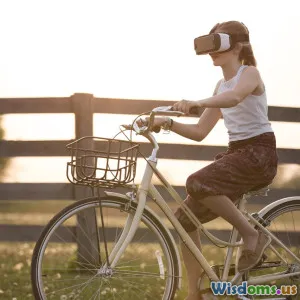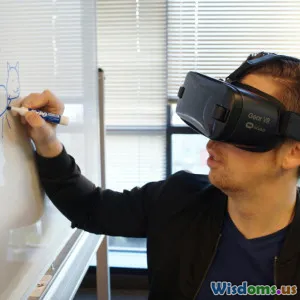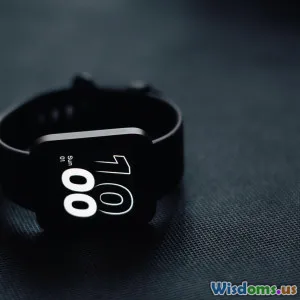
Seven Surprising Ways AR Applications Transform Retail Experiences
8 min read Explore seven unexpected ways AR reshapes retail, enhancing customer engagement, personalization, and sales through transformative technologies. (0 Reviews)
Seven Surprising Ways AR Applications Transform Retail Experiences
Introduction
Picture walking into your favorite store, pulling out your smartphone or glancing through smart glasses, and instantly seeing personalized product information floating beside each item or virtually trying on apparel without physically changing clothes. Augmented Reality (AR), once confined to science fiction and gaming, is rapidly revolutionizing the retail landscape in unexpected and transformative ways. While it's known for enhancing product visualization, AR's impact in retail extends far beyond that—improving customer engagement, streamlining operations, and even reshaping store designs.
This article uncovers seven surprising ways AR is transforming retail experiences, offering insights and real-world examples that showcase how retailers use AR to foster deeper connections with shoppers and improve bottom-line performance.
1. Virtual Try-Ons That Reduce Purchase Hesitation
Try-before-you-buy has long been a retailer’s challenge, especially for fashion and beauty products where fit and look are crucial. AR applications now allow customers to virtually try on clothes, shoes, glasses, or makeup using just a smartphone or interactive mirror.
Example:
Sephora’s Virtual Artist app enables users to try on thousands of lipstick shades and makeup products virtually in real-time. According to Sephora, customers engaged with AR features show a higher conversion rate than those who don’t, and the app has increased online sales significantly.
Similarly, Warby Parker’s virtual try-on tool uses AR to help customers see how glasses frames fit on their faces without stepping foot in a store.
Impact: This reduces hesitation, returns, and enhances customer satisfaction by removing guesswork in online and offline purchases.
2. Immersive Product Visualization in Real Environment
Imagine wanting to buy a new sofa, but uncertain if it fits your living room aesthetic or available space. AR offers an immersive experience that overlays digital images of products into your real-world environment, offering scale and style previews.
Real-World Insight:
IKEA Place, an AR app launched by the Swedish furniture giant, allows shoppers to view true-to-scale 3D furniture models in their homes. The app’s user engagement led IKEA to report a decrease in product returns and enhanced customer confidence, underlining AR’s potential to bridge imagination and reality.
Retailers in electronics and home décor sectors also leverage this technology to help consumers make more informed choices.
Impact: Increases buying confidence, reduces product returns, and enhances post-purchase satisfaction.
3. Personalized Shopping through Data-Driven AR Experiences
AR’s real surprise lies in how it integrates with consumer data to create personalized offers and guidance during shopping.
By combining AR with AI and shopper analytics, stores are customizing recommendations as shoppers browse physical aisles.
Example:
Luxury apparel retailer Ralph Lauren uses AR mirrors that not only display the shopper in different outfits but also suggest complementary items based on purchase history and current inventory.
Such dynamic personalization tailors experiences, making shoppers feel understood and valued—fundamental factors in boosting brand loyalty.
4. Interactive In-Store Navigation and Product Discovery
Large retail spaces or supermarkets can overwhelm customers. AR simplifies the hunt using wayfinding applications that guide shoppers to desired products along optimized routes.
Case Study:
Lowe’s Holoroom How To allows customers in-store to receive AR-guided instructions for projects, while AR navigation with digital signage directs shoppers efficiently, enhancing convenience.
This technology cuts down shopping time, aids product discovery, and reduces frustration.
Impact: Creates seamless retail experiences by blending physical and digital navigation.
5. Engaging Gamification to Boost Brand Interaction
AR’s interactive nature makes it a powerful tool for gamifying retail experiences, making shopping entertaining and memorable.
From virtual scavenger hunts to collectible digital items linked to physical products, gamification fosters deeper customer involvement.
Example:
Niantic’s Pokémon Go campaign with retail partners in 2021 significantly boosted foot traffic, with some stores incorporating exclusive AR content in-store. Brands like Tommy Hilfiger created in-store AR games that unlocked promotions and discounts.
Impact: Encourages repeat visits, amplifies word-of-mouth, and merges entertainment with commerce.
6. Enhanced Post-Purchase Support and Education
AR applications extend into after-sales support, offering interactive guides on product setup, use, or maintenance.
For example, consumer electronics companies provide AR overlays on manuals to show users step-by-step troubleshooting directly on their devices.
Real Example:
Samsung’s AR-enabled user manuals have reduced customer support calls by guiding users visually and interactively, leading to better product experiences.
This dimension enhances brand perception by emphasizing service and customer care.
7. Data-Driven Store Layout Optimization
Behind the scenes, retailers are using AR to simulate in-store layouts before physical implementation.
By visualizing how changes affect shopper behavior and product placements within AR, managers can test and optimize store setups cost-effectively.
Insight:
At Walmart, AR simulations helped design efficient shelf arrangements, optimizing product visibility and purchase likelihood, informed by shopper heatmaps.
Impact: Enhances operational efficiency, leading to better resource use and increased sales.
Conclusion
Augmented Reality is no longer a futuristic novelty but an essential tool transforming retail in multifaceted ways. From reducing consumer hesitation through virtual trials to enriching post-purchase support, AR injects engagement and personalization unprecedented in traditional retailing.
As AR technologies become more accessible and integrated with AI and big data, their potential to revolutionize shopping experiences grows.
Retailers who embrace and experiment with these seven surprising AR applications stand to redefine customer relationships, enhance operational efficiency, and stay competitive in an evolving marketplace.
The future of retail is undoubtedly immersive, interactive, and personalized—with AR lighting the way.
Are you a retailer or brand looking to innovate? Consider how incorporating AR could unlock hidden value in your retail journey, creating experiences that resonate and convert.
Rate the Post
User Reviews
Popular Posts


















